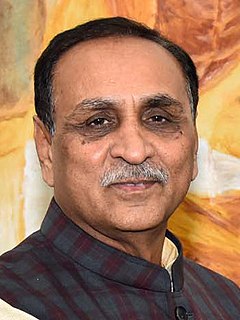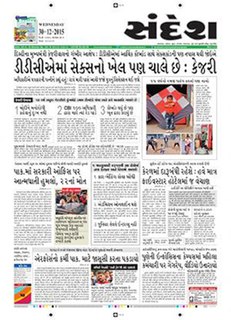
Narendra Damodardas Modi is an Indian politician serving as the 14th and current Prime Minister of India since 2014. He was the Chief Minister of Gujarat from 2001 to 2014, and is the Member of Parliament for Varanasi. Modi is a member of the Bharatiya Janata Party (BJP), and of the Rashtriya Swayamsevak Sangh (RSS), a Hindu nationalist volunteer organisation. He is the first prime minister outside of the Indian National Congress to win two consecutive terms with a full majority, and the second one to complete five years in office after Atal Bihari Vajpayee.

Bandhani is a type of tie-dye textile decorated by plucking the cloth with the fingernails into many tiny bindings that form a figurative design. The term bandhani is derived from the Sanskrit verbal root bandh. Today, most Bandhini making centers are situated in Gujarat, Rajasthan, Sindh, Punjab region and in Tamil Nadu where it is known as Sungudi. Earliest evidence of Bandhani dates back to Indus Valley Civilization where dyeing was done as early as 4000 B.C. The earliest example of the most pervasive type of Bandhani dots can be seen in the 6th century paintings depicting the life of Buddha found on the wall of Cave 1 at Ajanta. Bandhani is also known as Bandhej Saree, Bandhni, Piliya, and Chungidi in Tamil and regional dialects. Other tying techniques include Mothra, Ekdali and Shikari depending on the manner in which the cloth is tied. The final products are known with various names including Khombi, Ghar Chola, Patori and Chandrokhani

Jainism has had a significant influence in Gujarat.
The history of Gujarat began with Stone Age settlements followed by Chalcolithic and Bronze Age settlements like Indus Valley Civilisation. Gujarat's coastal cities, chiefly Bharuch, served as ports and trading centers in the Nanda, Maurya, Satavahana and Gupta empires as well as Western Kshatrapas period. After the fall of the Gupta empire in the 6th century, Gujarat flourished as an independent Hindu/Buddhist state. The Maitraka dynasty, descended from a Gupta general, ruled from the 6th to the 8th centuries from their capital at Vallabhi, although they were ruled briefly by Harsha during the 7th century. The Arab rulers of Sindh sacked Vallabhi in 770, bringing the Maitraka dynasty to an end. The Gurjara-Pratihara Empire ruled Gujarat after from the 8th to 10th centuries. As well as, for some periods the region came under the control of Rashtrakuta Empire and Pala Empire. In 775 the first Parsi (Zoroastrian) refugees arrived in Gujarat from Greater Iran.

Gujarat Samachar is a Gujarati language daily newspaper in India.

The 2002 Gujarat riots, also known as the 2002 Gujarat violence and the Gujarat pogrom, was a three-day period of inter-communal violence in the western Indian state of Gujarat. Following the initial incident, there were further outbreaks of violence in Ahmedabad for three months; statewide, there were further outbreaks of violence against the minority Muslim population for the next year. The burning of a train in Godhra on 27 February 2002, which caused the deaths of 58 Hindu pilgrims karsevaks returning from Ayodhya, is cited as having instigated the violence.

Vijay Ramniklal Rupani is an Indian politician from the Bharatiya Janata Party. He has been chief minister of Gujarat since 7 August 2016, and is a member of the Gujarat Legislative Assembly representing Rajkot West.

Sandesh is a leading daily newspaper in Gujarat. It is published in Gujarati and was founded in 1923.
The Kagzi also pronounced kagdi are a Muslim community found in the states of Gujarat and Maharashtra in India.
The Makrani are a Muslim community found in the state of Gujarat in India and Pakistan.
The Node are a Muslim community found in the state of Gujarat in India and a province of Sindh in Pakistan. They are one of a number of communities of pastoral nomads found in the Banni region of Kutch. The community is also known as Nodi or Nodhi
The Shaikhda or Shaikhra are a Muslim community found in the state of Gujarat in India.
The Chundrigar are a Muslim community found in the state of Gujarat, India. A few are also found in the city of Karachi, Pakistan.
The Tai are a Muslim community found in the state of Gujarat in India. There is also a large diaspora in the city of Karachi in Pakistan.
The Shaikh are a Muslim community found in the state of Gujarat in India. They are part of the larger Shaikh community of South Asia. Included within the Shaikh community are the Shaikhda of Bharuch district and the Sodagar of Patan.

Gujarati Pathans are a group of Pathans. At various times in history, a large number of Pashtuns have settled in the region of Gujarat in western India. They now form a distinct community of Gujarati speaking Muslims. They are distributed throughout the state, but live mainly in Ahmedabad, Rajkot, Junagadh, Surat, Bhavnagar, Panchamahal, Koth, Kotha, Borsad, Kheda, Banaskantha, Bharuch, Gandhinagar, Sabarkantha, Vadodara and Mehsana. They speak Gujarati, with many Hindustani loanwords. Common Tribes include Babi or Babai, Khan, Bangash, Durrani, and Yousafzai.
The Panar are a Muslim community found in the state of Gujarat in India.

Amit Anilchandra Shah is an Indian politician and the current Minister of Home Affairs who has been President of the Bharatiya Janata Party (BJP) since 2014. He was elected to the lower House of Parliament the Lok Sabha in the 2019 Indian general election from Gandhinagar. He was earlier elected as a member of the upper House of Parliament the Rajya Sabha from Gujarat in 2017. He is the chief strategist of the BJP and a close aide to Narendra Modi.
The Media in Gujarati language started with publication of Bombay Samachar in 1822. Initially the newspapers published business news and they were owned by Parsi people based in Bombay. Later Gujarati newspapers started published from other parts of Gujarat. Several periodicals devoted to social reforms were published in the second half of the 19th century. After arrival of Mahatma Gandhi, the Indian independence movement peaked and it resulted in proliferation of Gujarati media. Following independence, the media was chiefly focused on political news. After bifurcation of Bombay state, the area of service changed. Later there was an increase in readership due to growth of literacy and the media houses expanded its readership by publishing more number of editions. Later these media houses ventured into digital media also. The radio and television media expanded after 1990.











